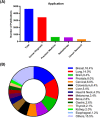Artificial intelligence for assisting cancer diagnosis and treatment in the era of precision medicine
- PMID: 34613667
- PMCID: PMC8626610
- DOI: 10.1002/cac2.12215
Artificial intelligence for assisting cancer diagnosis and treatment in the era of precision medicine
Abstract
Over the past decade, artificial intelligence (AI) has contributed substantially to the resolution of various medical problems, including cancer. Deep learning (DL), a subfield of AI, is characterized by its ability to perform automated feature extraction and has great power in the assimilation and evaluation of large amounts of complicated data. On the basis of a large quantity of medical data and novel computational technologies, AI, especially DL, has been applied in various aspects of oncology research and has the potential to enhance cancer diagnosis and treatment. These applications range from early cancer detection, diagnosis, classification and grading, molecular characterization of tumors, prediction of patient outcomes and treatment responses, personalized treatment, automatic radiotherapy workflows, novel anti-cancer drug discovery, and clinical trials. In this review, we introduced the general principle of AI, summarized major areas of its application for cancer diagnosis and treatment, and discussed its future directions and remaining challenges. As the adoption of AI in clinical use is increasing, we anticipate the arrival of AI-powered cancer care.
Keywords: artificial intelligence; cancer diagnosis; cancer research; cancer treatment; convolutional neural network; deep learning; deep neural network; oncology.
© 2021 The Authors. Cancer Communications published by John Wiley & Sons Australia, Ltd. on behalf of Sun Yat-sen University Cancer Center.
Conflict of interest statement
The authors declare that they have no competing interests.
Figures



References
-
- McCarthy J, Minsky ML, Rochester N, Shannon CE. A proposal for the dartmouth summer research project on artificial intelligence, august 31, 1955. AI Magazine. 2006;27(4):12.
-
- Yasser E‐M, Honavar V, Hall A. Artificial Intelligence Research Laboratory. 2005.
-
- Yu KH, Beam AL, Kohane IS. Artificial intelligence in healthcare. Nat Biomed Eng. 2018;2(10):719–31. - PubMed
-
- Siegel RL, Miller KD, Jemal A. Cancer statistics, 2020. CA Cancer J Clin. 2020;70(1):7–30. - PubMed
-
- Wainberg M, Merico D, Delong A, Frey BJ. Deep learning in biomedicine. Nat Biotechnol. 2018;36(9):829–38. - PubMed
Publication types
MeSH terms
LinkOut - more resources
Full Text Sources
Medical
Research Materials
Miscellaneous

